
As of 2023, about 50% of all businesses that outsource their business operations have at least one IT vendor from India. According to the Indian Department of Commerce, in 2021-2022, telecommunication, computer, and information services brought $125.6 billion in export value to the Indian budget. How has India managed to become the top global destination for IT outsourcing, and is it a one-size-fits-all business solution? Let’s discuss.
Content:
- Why is India so popular for outsourcing?
- Tech leaders that outsource software development to India
- Top 10 IT service companies in India
- What IT services can you delegate to India?
- What are the problems with outsourcing to India?
- Summing up
Why is India so popular for outsourcing?
During the last decade, India has grown dramatically. In June 2023, it outrun China and became the country with the largest population of 1,429,731,249 people. But it’s not only the population (and the labor market) that grows! India’s IT outsourcing industry is worth over $125 billion and employs over 4 million people.
The largest pool of labor force, strong friendly IT policy of the Indian government, high standards of tech education, good English command, high quality of IT services, and relatively low prices have made India an IT outsourcing hub of the world.
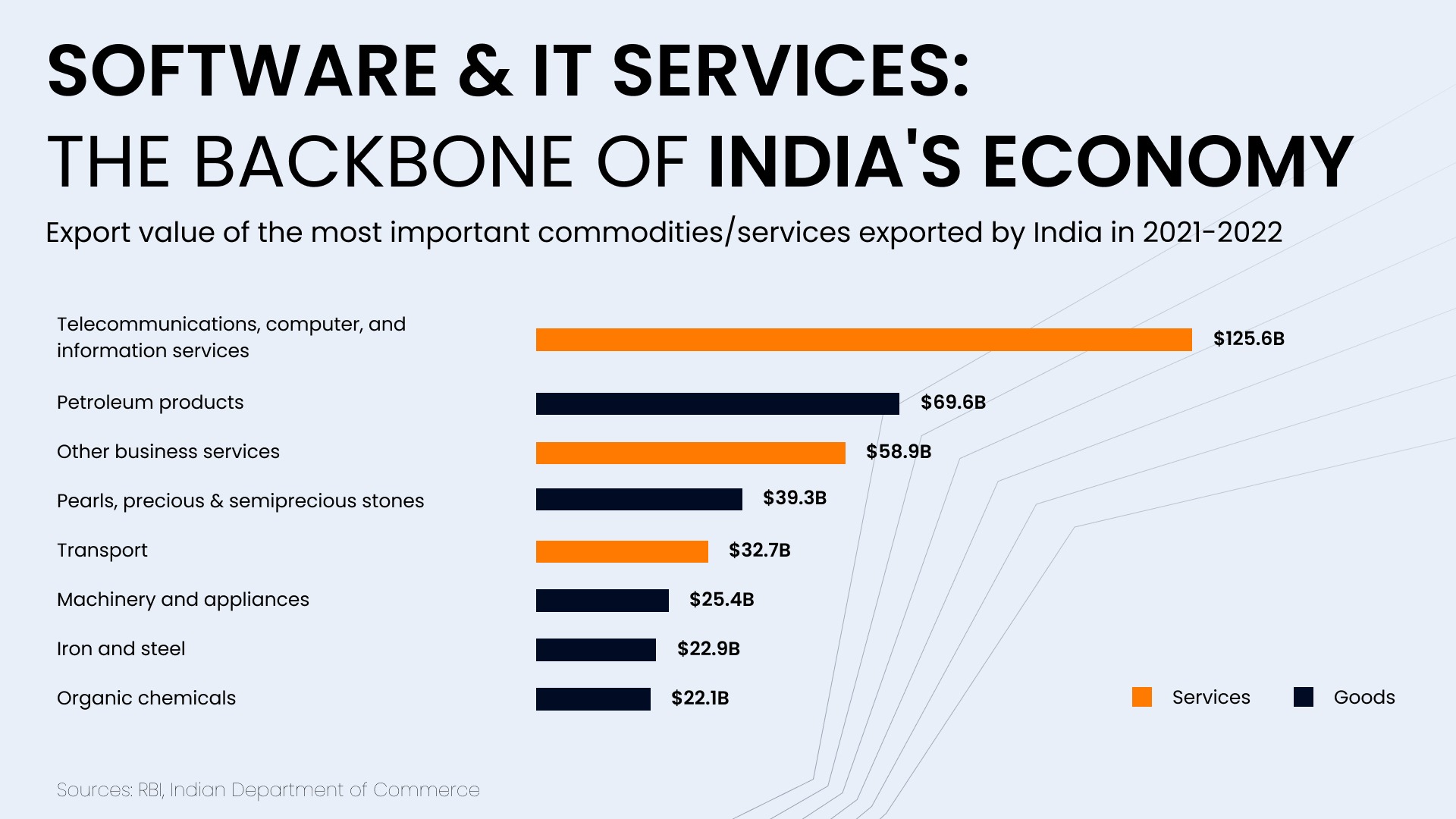
According to the Indian Brand Equity Foundation, the United States and the United Kingdom are two pivotal partners of Indian IT vendors. As of 2019 (latest data available), 62% of IT services imported from India in percent of revenue, were imported by the USA. The United Kingdom imported 17% of Indian IT services.
So, how did it happen?
- Indian outsourcing companies understand their core clients and provide training to their employees to prevent cultural mismatches or similar difficulties associated with business processes offshoring.
- Indian software developers are of high value in the world due to their experience and skills. Whenever you have a coding problem, you will probably find the answer in a YouTube video by an Indian programmer. “Indian English is the language of knowledge,” software developers worldwide say jokingly.
- Even though India does not specifically regulate outsourcing, its government supports the IT sector and national IT vendors. The reason is simple – software and IT services are the backbone of India’s economy.
- Low cost of living, low salaries, and low prices for international clients. That’s how it USED TO BE about five years ago. Today, Indian IT vendors see the enormous demand for their services and start raising prices. However, the cost of software development in India is still three to four times lower than in the US or the UK.
Tech leaders that outsource software development to India
Another aspect that adds to Indian popularity as an IT hub is its clientele. For years, the US-based technology companies have witnessed substantial growth and expansion in India, enticed by the abundance of cost-effective, proficient English-speaking talent with technical expertise.
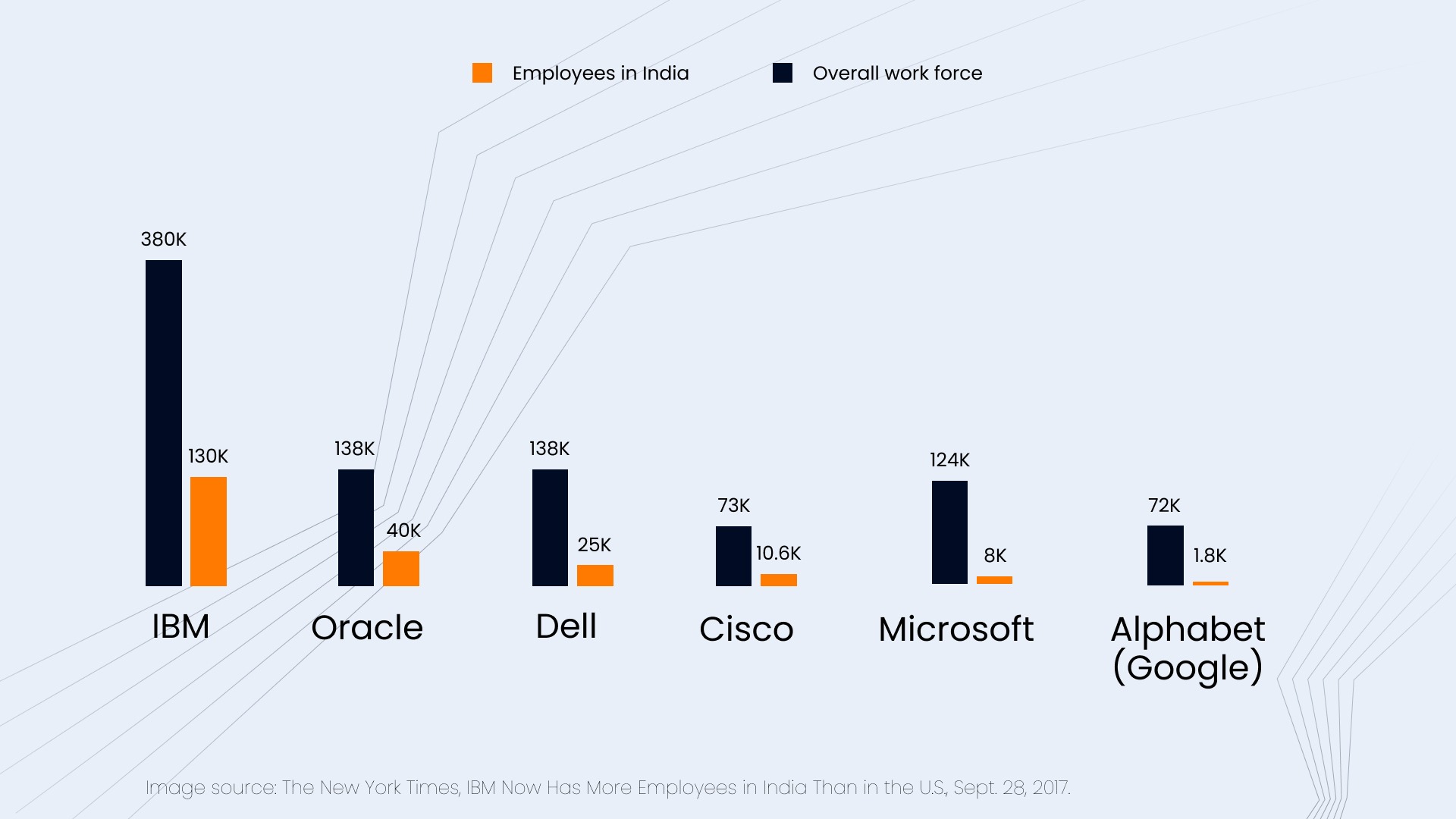
Image source: The New York Times, IBM Now Has More Employees in India Than in the U.S., Sept. 28, 2017.
Microsoft
Microsoft started delegating part of its business activities to Indian IT vendors as early as 2004. The global technology conglomerate embarked on a significant initiative, entrusting software development and customer support operations to India. Microsoft further intensified its outsourcing endeavors in 2010 through a strategic alliance with Infosys, a prominent Indian outsourcing vendor.
Recognizing the paramount importance of safeguarding its outsourced business processes, Microsoft proactively fortified its investments in cybersecurity for India in 2016. This measure was taken in response to the mounting cybersecurity challenges faced by Indian companies during that particular year. By allocating additional resources to enhance security measures, Microsoft aimed to uphold the integrity and protection of its outsourced operations within the country. Microsoft actively engages in software development, cloud services, cybersecurity solutions, as well as customer support and testing to extend internet connectivity to rural areas within India.
Amazon
Following the path paved by Microsoft, Amazon has embraced the strategy of outsourcing to India. In 2015, the company initiated its outsourcing endeavors by entrusting customer support services to the capable hands of Indian professionals. This strategic move has proven advantageous, enabling Amazon to achieve substantial cost savings in terms of labor and resources when compared to establishing an in-house team within the United States.
Continuing its relentless expansion in India, Amazon took further steps in 2018 by engaging call centers. This strategic decision allowed them to accommodate more local and international customers and sellers.
Cisco
Cisco created a manufacturing facility in India in 2006, displaying a steadfast commitment to augmenting its investments over the years. Cisco has also established its second-largest research and development center in the country. This center has become a hub of innovation, accommodating a talented workforce comprising over 1,600 skilled professionals. Their collective expertise contributes to advancing Cisco’s technological prowess and reinforces its position in the industry.
It all began with outsourcing AdWords phone and email support services to call centers in India in 2011. In line with its growth objectives, Google further expanded its IT outsourcing endeavors in 2016, forging a partnership with Cognizant. As time progressed, the company refined its outsourcing strategy, gradually entrusting non-core business processes such as software development and network management of Gmail, maps, and YouTube to external service providers.
Recently, the largest search engine announced its intention to bolster its workforce in multiple countries, including India, by hiring additional personnel. This strategic move aligns with their vision for enhancing operational efficiency and nurturing local talent pools to drive future growth.
Apart from the above giants, there are also IBM, Oracle, and Dell.
- IBM has delegated to India a wide range of activities, including research initiatives and overseeing computer network management for numerous global corporations.
- Oracle focused on software development and boasted a substantial workforce in the country, second only to the United States.
- Dell leverages its presence in India for research and development, consulting services, and the management of computing systems.
Top 10 IT service companies in India
We composed this rating based on the number of employees in the company, its overall reputation, reviews from customers, the time the IT vendor is on the market, and the average prices of its projects. The main source of data gathered in this part is Clutch, a global platform for honest reviews.

Uplers
- Average hourly rate: $25-49 per hour
- Number of employees: 1000+ employees
- Founded in: 2003
- Main office: Ahmedabad
- Core services provided: web development, design, digital and email marketing
- Most common project size: less than 10,000$
- Average referral rating on Cutch: 4.9/5
Experion Technologies
- Average hourly rate: $25-49 per hour
- Number of employees: 1000+ employees
- Founded in: 2006
- Main office: Kazhakkoottam
- Core services provided: custom software development, web development, big data consulting
- Most common project size: $50,000 to $199,999
- Average referral rating on Cutch: 4.9/5
Successive Digital
- Average hourly rate: $25-49 per hour
- Number of employees: 1000+ employees
- Founded in: 2012
- Main office: Noida
- Core services provided: mobile app development, cloud consulting, e-commerce development
- Most common project size: $10,000 to $49,000
- Average referral rating on Cutch: 4.9/5
Cisin
- Average hourly rate: $25+ per hour
- Number of employees: 1000+ employees
- Founded in: 2012
- Main office: Indore
- Core services provided: AI development, cloud consulting, custom software development, e-commerce development, IT managed services, IT staff augmentation
- Most common project size: less than $10,000
- Average referral rating on Cutch: 5/5
Kellton
- Average hourly rate: $50-99 per hour
- Number of employees: 1000+ employees
- Founded in: 2009
- Main office: Gurugram
- Core services provided: custom software development, mobile app development, blockchain, cloud consulting, AI development
- Most common project size: $200,000 to $999,999
- Average referral rating on Cutch: 4.8/5
Bacancy
- Average hourly rate: $25+ per hour
- Number of employees: 1000+ employees
- Founded in: 20011
- Main office: Ahmedabad
- Core services provided: custom software development, web development, big data consulting, cloud consulting, IT staff augmentation, IT managed services
- Most common project size: $10,000 to $49,000
- Average referral rating on Cutch: 4.7/5
Algoworks
- Average hourly rate: $25-49 per hour
- Number of employees: 250+ employees
- Founded in: 2006
- Main office: Noida
- Core services provided: mobile app development
- Most common project size: $10,000 to $49,000
- Average referral rating on Cutch: 4.9/5
Simform
- Average hourly rate: $25-49 per hour
- Number of employees: 250+ employees
- Founded in: 2010
- Main office: Ahmedabad
- Core services provided: custom software development, mobile app development, cloud consulting, AI development, web development
- Most common project size: $10,000 to $49,000
- Average referral rating on Cutch: 4.8/5
Josh Software
- Average hourly rate: $100-149 per hour
- Number of employees: 250+ employees
- Founded in: 2007
- Main office: Pune
- Core services provided: custom software development, mobile app development
- Most common project size: $10,000 to $49,000
- Average referral rating on Cutch: 4.7/5
Indus Net Technologies
- Average hourly rate: $25-49 per hour
- Number of employees: 250+ employees
- Founded in: 1997
- Main office: Kolkata
- Core services provided: blockchain, big data consulting, AI consulting, AI development
- Most common project size: $10,000 to $49,000
- Average referral rating on Cutch: 4.9/5
What IT services can you delegate to India?
These are IT services you can outsource to India, from the most common among IT vendors to the most unique ones:
- Customer service outsourcing
- Call center services
- Custom software development
- Mobile app development
- Web development
- SEO
- AI consulting
- Cloud consulting
- UI/UX design
- SRM consulting and SI
- AI development
- Blockchain
- BI and big data consulting
- AR/VR development
- IT strategy consulting
- IT managed services
- IT outstaffing
Like anywhere in the world, Indian IT vendors offer mostly traditional outsourcing services. More coherent approaches that allow customers to create IT ecosystems and strategic partnerships (IT staff augmentation and IT managed services) are not widely spread in the country.
Here is another piece of data showing the most popular IT services outsourced to Indian vendors:
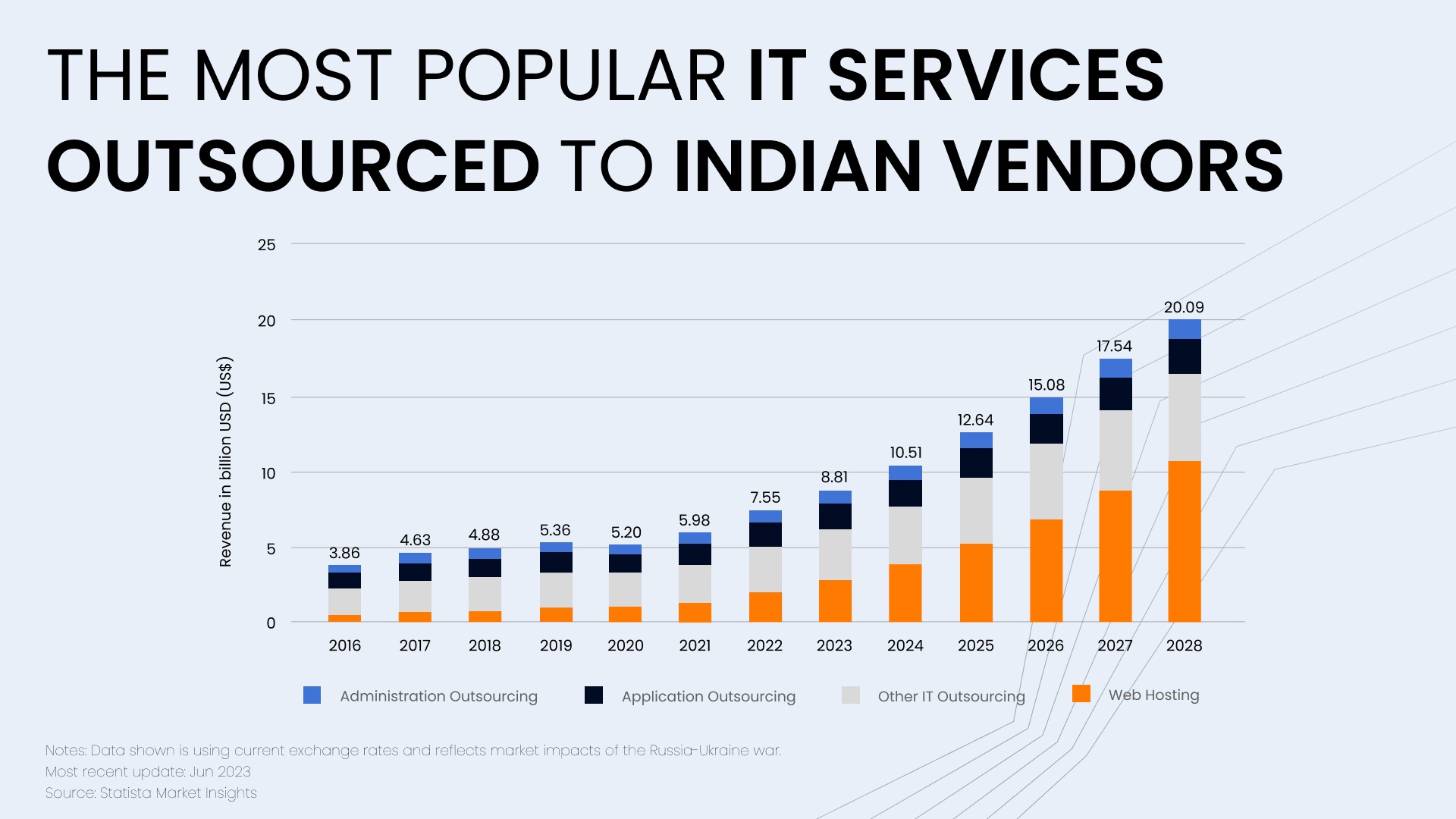
What are the problems with outsourcing to India?
Even though outsourcing to India is cost-efficient and quite safe, you should be aware of some pitfalls.
1. Data and trade secrets protection
According to the International IP Index 2023, India is ranked lowly in all categories of intellectual property protection. Below is India’s place in trade secrets and the protection of the confidential information category.
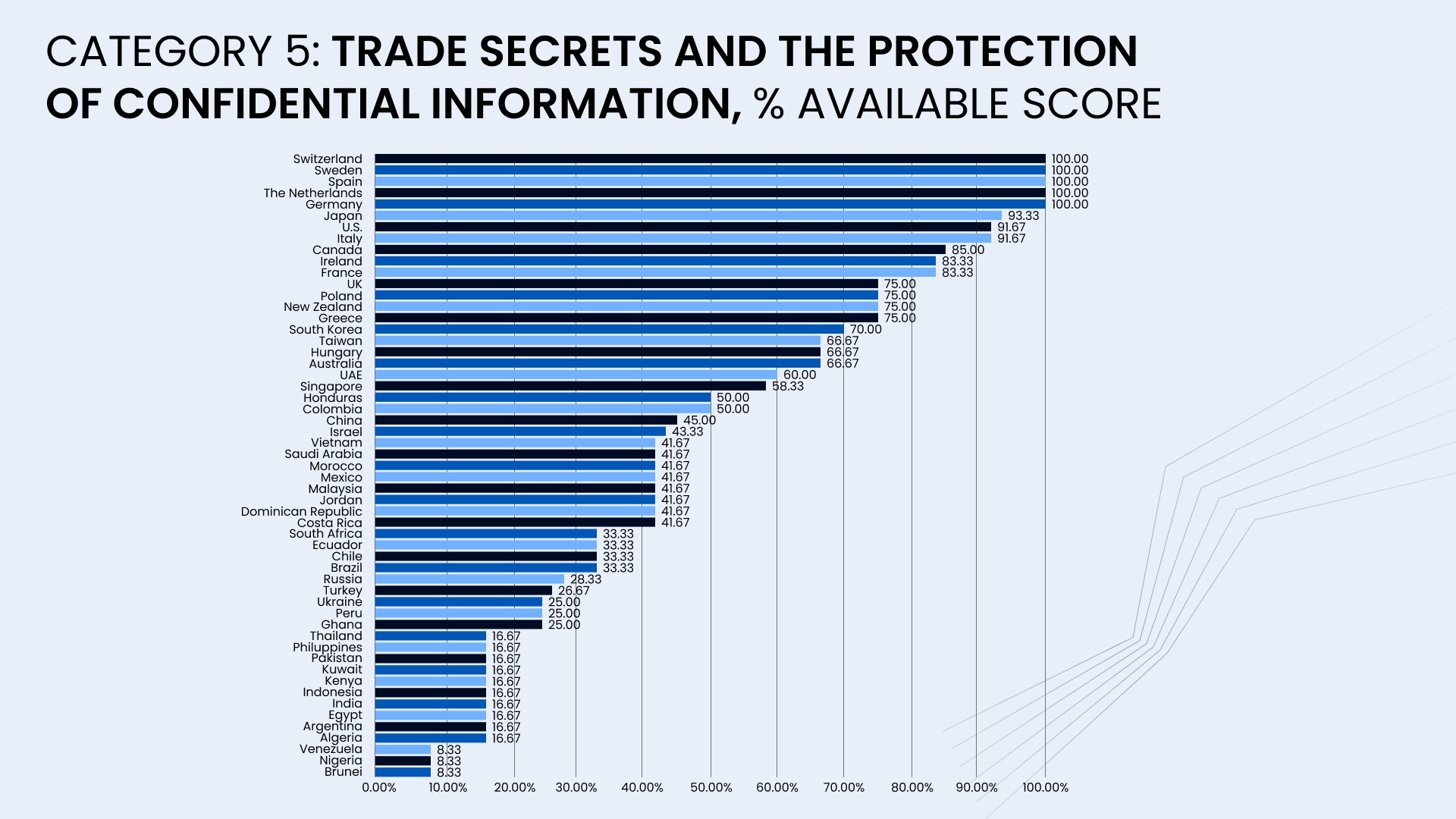
Image source: U.S. Chamber of Commerce 2023 International Intellectual Property Protection Index.
India is ranked low in other categories as well, which are:
- Patents
- Copyrights
- Trademarks
- Design rights, related rights, and limitations
Consider signing a non-disclosure agreement and other types of contracts that will help you secure your trade secrets and other sensitive data you might be entrusting to your Indian vendor.
2. Increasing price levels
Long ago passed the days when India was a place of cheap labor. In 2023, Indian IT infrastructure understands its value and steadily increases developers’ salaries and fees for software development.
As of July 2023, the average salary of an Indian IT specialist is almost equal to the remuneration of the same-level specialist in Poland (annual salary is $45.000) and 25% higher than in Ukraine. Suppose you’re a Western European or Israelian company. In that case, you might find cooperation with Eastern European IT vendors more convenient, as they are in your time zone and have a closer cultural affinity.
3. Lack of coherent strategic solutions
Indian IT vendors conducted an efficient gap analysis and corrected most of the imperfections it used to have. Namely, companies work in several time zones, conduct business ethics and culture affinity training for their employees, and provide corporate English lessons.
However, some flaws are still there. Namely, those connected with the traditional outsourcing approach itself.
Indian IT vendors haven’t yet accepted the new approaches to outsourcing, like staff augmentation, IT managed services, or operate services. That is why you will find it difficult to reinforce your in-house staff by hiring a dedicated team from India.
4. Global Location Assessment
According to the 2021 Kearney Global Services Location Index, India, renowned for its longstanding prominence in the overall GSLI, presently occupies a more modest 17th position in the digital-resonance ranking.
The reason is that India falls short in terms of digital skills and outputs. Despite substantial investments in technology and a thriving startup ecosystem in pivotal domains like energy, media, and retail, India faces a severe scarcity of skilled professionals.
India was among the pioneering nations to successfully harness the initial wave of IT and BPO outsourcing demands while consistently fostering the development of low-skilled workforces to fulfill conventional requirements. However, the ever-evolving landscape of digital transformation has spawned a gap between the demand for digital professionals and the talent pool that India presently cultivates.
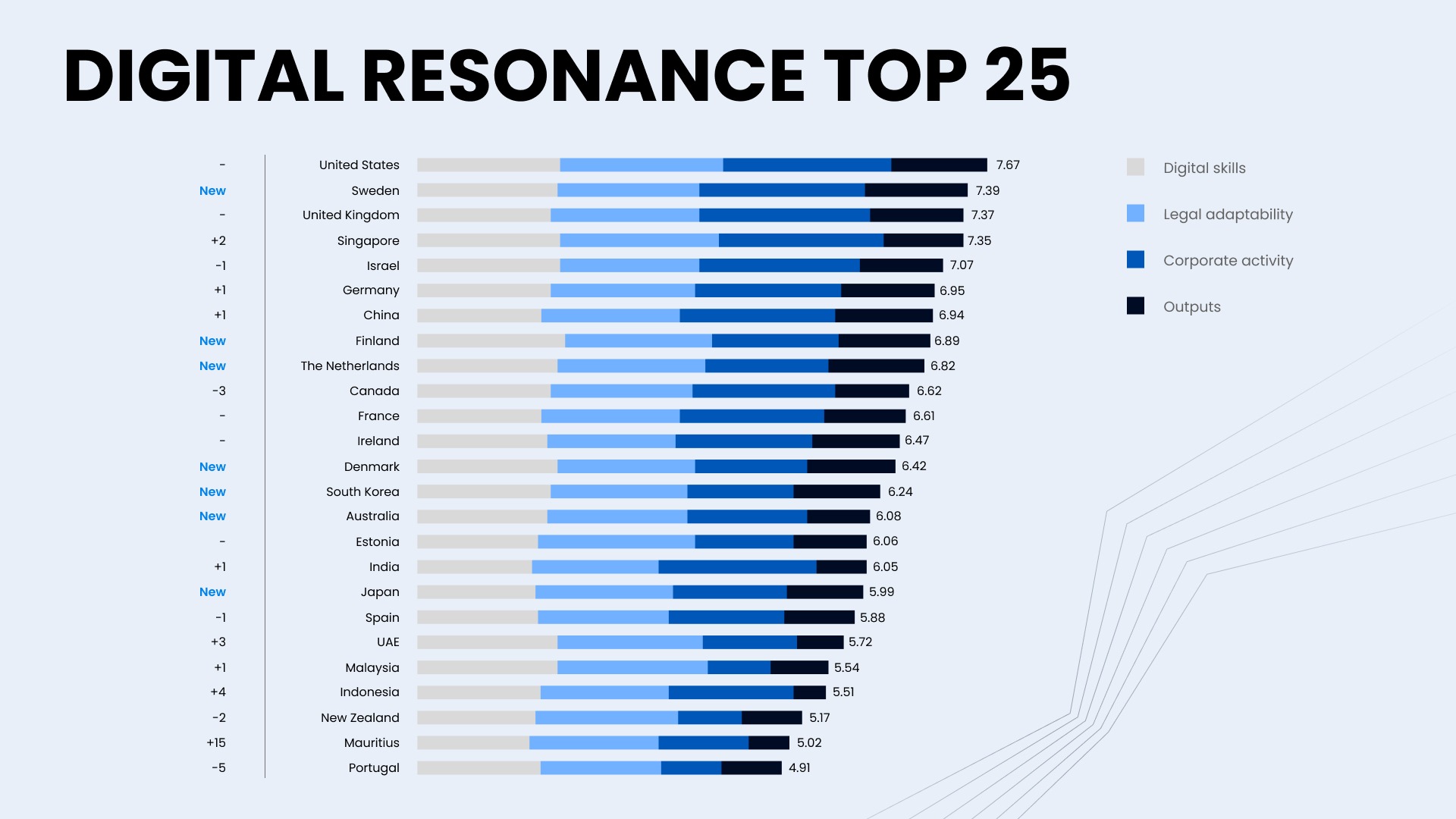
Image source: The 2021 Kearney Global Services Location Index
Summing up
In summary, we would like to answer some common questions about India really quickly.
- Why is India so popular for outsourcing?
Due to its huge population, good command of English, high level of performance, and relatively low direct labor costs.
- Is India a leading country in outsourcing?
Yes. If not the leading, it is definitely among the two most popular destinations for services and manufacturing outsourcing.
- Is outsourcing good for India?
Yes, outsourcing, namely IT outsourcing, is the largest import category for India. The country receives more funds from its international customers and has more possibilities to invest in its further development.
- What are the problems with outsourcing to India?
Almost all problems you will find can be easily fixed. A proper non-disclosure agreement can cover data protection issues, and choosing overlapping working hours will fix the different time zones’ problems. However, some tendencies might make India less cost-efficient for international customers as the country’s economy develops rapidly, leading to increasing prices for software development and other IT services.
- What companies are outsourcing to India?
Most Indian IT vendors’ customers are from the USA and the United Kingdom. Together they make up over 75% of all Indian customers. Among the most notorious companies which outsource their business processes and IT services to India are Amazon, Google, Microsoft, IBM, Cisco, and Dell.
- Is outsourcing illegal in India?
No. However, Indian legislation might be quite controversial trying to legalize all aspects of outsourcing. Thus, always consult a lawyer who specifies in Indian legislation before you sign a contract with an Indian-based IT vendor.
- Why is IT cheaper to outsource to India?
This is because the country has a relatively low cost of living and low direct labor costs, especially compared to developed economies like the USA, UK, Germany, or Israel. However, not all IT services should be delegated to cheap vendors. One of the problems India acknowledges is that it lacks highly skilled top-tier specialists able to come up with innovative solutions.
For example, if you want to outsource an R&D service, which is all about innovations and finding new paths, consider vendors from other countries. Ukraine can become your choice as it has highly skilled experts and local IT vendors charge relatively low fees.
- Is India’s outsourcing good for a global economy?
Overall, outsourcing does more good for the global economy than bad. Outsourcing countries receive services and products at lower costs, while countries that are still developing receive additional funds, which they can further invest in their own development.
- Is India destined to become a new economic superpower?
It is highly likely that India will soon become a new economic superpower. You can check out the recent DW video report to have this question answered in more detail by professional economists.
